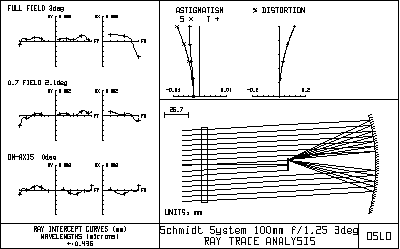SCHMIDT.LEN - A SCHMIDT CAMERA
Schmidt shows the application of an aspheric surface as well as an obstruction in the setup of a wide-field telescope. A Schmidt camera consists of a spherical mirror with an aspheric corrector plate at or near the center of curvature of the mirror. The purpose of the aspheric plate is to correct the spherical aberration of the mirror. In the design included here, an additional lens is placed near the image plane to correct field aberrations on a flat image plane (a normal Schmidt camera has a curved image surface). The system data is shown below.
*LENS DATA Schmidt System 100mm f/1.25 3deg SRF RADIUS THICKNESS APERTURE RADIUS GLASS SPE NOTE
0 — 1.0000e+20 5.2408e+18 AIR 1 2.6134e+03 6.500000 42.000000 FSILICA * 2 — 88.660000 42.000000 AP AIR 3 — 98.860000 42.000000 X AIR *
4 -201.029000 -96.860000 P 55.000000 REFL_HATCH 5 -40.500000 -2.000000 7.000000 FSILICA P 6 234.033000 -0.416671 7.000000 P AIR P 7 — — 5.300000
*CONIC AND POLYNOMIAL ASPHERIC DATA
SRF CC AD AE AF AG 1 -1.000000 -5.8678e-08 -4.2209e-12 1.2779e-15 -3.0697e-19 *PICKUPS 2 AP 1 4 THM 3 2.000000 5 GLA 1 6 GLA 3 AP 5
*APERTURES SRF TYPE APERTURE RADIUS
0 SPC 5.2408e+18 1 SPC 42.000000 2 PKP 42.000000 3 SPC 42.000000 Special Aperture Group 0: A ATP Ellipse AAC Obstruct AAN — AX1 -7.000000 AX2 7.000000 AY1 -7.000000 AY2 7.000000
4 SPC 55.000000 5 SPC 7.000000 6 PKP 7.000000 7 SPC 5.300000
Note that an obstruction must be placed on surface 3 to block the rays that hit the image surface before hitting the primary mirror. The obstruction is specified as a special aperture as shown, and is marked not drawable, so that it does not appear in the lens drawing. The performance of the system is indicated in the ray analysis below. Note that the ray-intercept curves are not smooth. This is characteristic of designs that use high-order aspherics, as this one does. It is likely that the curves could be smoothed out by careful weighting of the variables during optimization.

